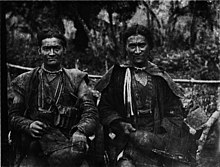Kanakanavu people
show This article may be expanded with text translated from the corresponding article in Chinese. (October 2014) Click [show] for important translation instructions. |
卡那卡那富 | |
|---|---|
 | |
| Total population | |
| ~338 (June 2018) | |
| Regions with significant populations | |
| Taiwan | |
| Languages | |
| Kanakanavu, Bunun, Mandarin, Taiwanese Hokkien | |
| Religion | |
| Animism, Christianity (majority)[1] | |
| Related ethnic groups | |
| Tsou, Bunun, Saaroa, Taiwanese Aborigines |
The Kanakanavu (Chinese: 卡那卡那富族; Wade–Giles: Kanakanavu) are an indigenous people of central southern Taiwan. They live in the two villages of Manga and Takanua in Namasia District, Kaohsiung City, Taiwan.[2]
History[]
The native Kanakanavu speakers were Taiwanese aboriginals living on the islands. Following the Dutch Colonial Period in the 17th century, Han-Chinese immigration began to dominate the islands population. The village of is a village assembled by Japanese rulers to relocate various aboriginal groups in order to establish easier dominion over these groups.[3]
On 26 June 2014, the government recognized Kanakanavu as the 16th group of Taiwanese indigenous peoples.[4]
Livelihood[]
Japanese occupation left evidence of how the culture functioned. Forest clearance allowed agriculture to be the main facet of society, followed by hunting and fishing. Maize, Rice, Millet, Taro, Sweet Potatoes, beans, and soybeans were the staple crops.[1]
Spirituality[]
Kanakanavu practiced a polytheistic nature religion involving offerings, fertility rituals, and shamanism. Headhunting was a common practice until Christianization took over.[5]
See also[]
- Kanakanavu language
- Taiwanese aborigines
References[]
- ^ Jump up to: a b "Cultural Setting". Kanakanavu: An Aboriginal Language on Taiwan. Archived from the original on 2016-09-27. Retrieved 2018-06-17.
- ^ Zeitoun, Elizabeth; Teng, Stacy F. (2014). The Position of Kanakanavu and Saaroa within the Formosan Languages Revisited (PDF). The 14th International Symposium on Chinese Languages and Linguistics (IsCLL-14), June 4–9, 2014. Academia Sinica, Taipei. Archived from the original (PDF) on 2014-06-06. Retrieved 2015-07-16.
- ^ "Ethnographic Setting". Kanakanavu: An Aboriginal Language on Taiwan. Archived from the original on 2016-09-20. Retrieved 2018-06-17.
- ^ "Gov't Officially Recognizes Two More Aboriginal Tribes". The China Post. CNA. 2014-06-27. Archived from the original on 2014-11-11. Retrieved 2015-01-01.
- ^ "Social Setting". Kanakanavu: An Aboriginal Language on Taiwan. Archived from the original on 2016-09-27. Retrieved 2018-06-17.
- Taiwanese indigenous peoples
- Taiwanese people stubs
- Asian ethnic group stubs
